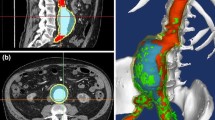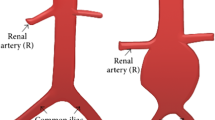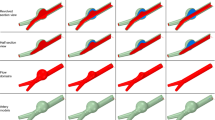Abstract
Abdominal aortic aneurysm (AAA) represents a degenerative disease process of the abdominal aorta that results in dilation and permanent remodeling of the arterial wall. A fluid structure interaction (FSI) parametric study was conducted to evaluate the progression of aneurysmal disease and its possible implications on risk of rupture. Two parametric studies were conducted using (i) the iliac bifurcation angle and (ii) the AAA neck angulation. Idealized streamlined AAA geometries were employed. The simulations were carried out using both isotropic and anisotropic wall material models. The parameters were based on CT scans measurements obtained from a population of patients. The results indicate that the peak wall stresses increased with increasing iliac and neck inlet angles. Wall shear stress (WSS) and fluid pressure were analyzed and correlated with the wall stresses for both sets of studies. An adaptation response of a temporary reduction of the peak wall stresses seem to correlate to a certain extent with increasing iliac angles. For the neck angulation studies it appears that a breakdown from symmetric vortices at the AAA inlet into a single larger vortex significantly increases the wall stress. Our parametric FSI study demonstrates the adaptation response during aneurysmal disease progression and its possible effects on the AAA risk of rupture. This dependence on geometric parameters of the AAA can be used as an additional diagnostic tool to help clinicians reach informed decisions in establishing whether a risky surgical intervention is warranted.








Similar content being viewed by others
References
ADINA Manual (2009) Theory and modeling guide: ARD 09-7, pp 667–668
Antiga L, Piccinelli M, Botti L, Ene-Iordache B, Remuzzi A, Steinman DA (2008) An image-based modeling framework for patient-specific computational hemodynamics. Med Biol Eng Comput 46:1097–1112
Beebe HG, Jackson T, Pigott JP (1995) Aortic aneurysm morphology for planning endovascular aortic grafts: limitations of conventional imaging methods. J Endovasc Surg 2:139–148
Bluestein D, Niu L, Schoephoerster RT, Dewanjee MK (1996) Steady flow in an aneurysm model: correlation between fluid dynamics and blood platelet deposition. J Biomech Eng Trans ASME 118:280–286
Bluestein D, Dumont K, De Beule M, Ricotta J, Impellizzeri P, Verhegghe B, Verdonck P (2009) Intraluminal thrombus and risk of rupture in patient specific abdominal aortic aneurysm—FSI modelling. Comput Methods Biomech Biomed Eng 12:73–81
Bonert M, Leask RL, Butany J, Ethier CR, Myers JG, Johnston KW, Ojha M (2003) The relationship between wall shear stress distributions and intimal thickening in the human abdominal aorta. Biomed Eng Online 2:18
Boyce MC, Arruda EM (2000) Constitutive models of rubber elasticity: a review. Rubber Chem Technol 73:504–523
Breeuwer M, de Putter S, Kose U, Speelman L, Visser K, Gerritsen F, Hoogeveen R, Krams R, van den Bosch H, Buth J, Gunther T, Wolters B, van Dam E, van de Vosse F (2008) Towards patient-specific risk assessment of abdominal aortic aneurysm. Med Biol Eng Comput 46:1085–1095
Chuong CJ, Fung YC (1986) On residual stresses in arteries. J Biomech Eng 108:189–192
Di Martino ES, Vorp DA (2003) Effect of variation in intraluminal thrombus constitutive properties on abdominal aortic aneurysm wall stress. Ann Biomed Eng 31:804–809
Di Martino ES, Guadagni G, Fumero A, Ballerini G, Spirito R, Biglioli P, Redaelli A (2001) Fluid–structure interaction within realistic three-dimensional models of the aneurysmatic aorta as a guidance to assess the risk of rupture of the aneurysm. Med Eng Phys 23:647–655
Doriot PA (2003) Some unusual considerations about vessel walls and wall stresses. J Theor Biol 221:133–141
Doyle BJ, Callanan A, Burke PE, Grace PA, Walsh MT, Vorp DA, McGloughlin TM (2009) Vessel asymmetry as an additional diagnostic tool in the assessment of abdominal aortic aneurysms. J Vasc Surg 49:443–454
Fillinger MF, Racusin J, Baker RK, Cronenwett JL, Teutelink A, Schermerhorn ML, Zwolak RM, Powell RJ, Walsh DB, Rzucidlo EM (2004) Anatomic characteristics of ruptured abdominal aortic aneurysm on conventional CT scans: implications for rupture risk. J Vasc Surg 39:1243–1252
Formaggia L, Gerbeau JF, Nobile F, Quarteroni A (2001) On the coupling of 3D and 1D Navier–Stokes equations for flow problems in compliant vessels. Comput Methods Appl Mech Eng 191:561–582
Fung YC (1991) What are the residual stresses doing in our blood vessels? Ann Biomed Eng 19:237–249
Fung YC (1993) Biomechanics, mechanical properties of living tissues, 2nd edn. Springer, New York
Gee MW, Forster C, Wall WA (2010) A computational strategy for prestressing patient-specific biomechanical problems under finite deformation. Int J Numer Method Biomed Eng 26:52–72
Guo X, Kono Y, Mattrey R, Kassab GS (2002) Morphometry and strain distribution of the C57BL/6 mouse aorta. Am J Physiol Heart Circ Physiol 283:H1829–H1837
Hallin A, Bergqvist D, Holmberg L (2001) Literature review of surgical management of abdominal aortic aneurysm. Eur J Vasc Endovasc Surg 22:197–204
Helderman F, Manoch IJ, Breeuwer M, Kose U, Schouten O, van Sambeek MR, Poldermans D, Pattynama PT, Wisselink W, van der Steen AF, Krams R (2008) A numerical model to predict abdominal aortic aneurysm expansion based on local wall stress and stiffness. Med Biol Eng Comput 46:1121–1127
Heng MS, Fagan MJ, Collier JW, Desai G, McCollum PT, Chetter IC (2008) Peak wall stress measurement in elective and acute abdominal aortic aneurysms. J Vasc Surg 47:17–22
Kleinstreuer C, Li ZH (2006) Analysis and computer program for rupture-risk prediction of abdominal aortic aneurysms. Biomed Eng Online 5:19
Lakatta EG, Mitchell JH, Pomerance A, Rowe GG (1987) Human aging: changes in structure and function. J Am Coll Cardiol 10:42A–47A
Leung JH, Wright AR, Cheshire N, Crane J, Thom SA, Hughes AD, Xu Y (2006) Fluid structure interaction of patient specific abdominal aortic aneurysms: a comparison with solid stress models. Biomed Eng Online 5:33
Li Z, Kleinstreuer C (2005) A new wall stress equation for aneurysm–rupture prediction. Ann Biomed Eng 33:209–213
Li ZH, Kleinstreuer C (2007) A comparison between different asymmetric abdominal aortic aneurysm morphologies employing computational fluid–structure interaction analysis. Eur J Mech B Fluids 26:615–631
Olufsen MS, Peskin CS, Kim WY, Pedersen EM, Nadim A, Larsen J (2000) Numerical simulation and experimental validation of blood flow in arteries with structured-tree outflow conditions. Ann Biomed Eng 28:1281–1299
Papaharilaou Y, Ekaterinaris JA, Manousaki E, Katsamouris AN (2006) A decoupled fluid structure approach for estimating wall stress in abdominal aortic aneurysms. J Biomech 40:367–377
Paszkowiak JJ, Dardik A (2003) Arterial wall shear stress: observations from the bench to the bedside. Vasc Endovascular Surg 37:47–57
Powell J, Brady A, Brown L, Forbes J, Fowkes F, Greenhalgh R, Ruckley C (1998) Mortality results for randomised controlled trial of early elective surgery or ultrasonographic surveillance for small abdominal aortic aneurysms. Thompson SG UK Small Aneurysm Trial Participants. Lancet 352:1649–1655
Raghavan ML, Vorp DA (2000) Toward a biomechanical tool to evaluate rupture potential of abdominal aortic aneurysm: identification of a finite strain constitutive model and evaluation of its applicability. J Biomech 33:475–482
Raghavan ML, Vorp DA, Federle MP, Makaroun MS, Webster MW (2000) Wall stress distribution on three-dimensionally reconstructed models of human abdominal aortic aneurysm. J Vasc Surg 31:760–769
Reneman RS, Arts T, Hoeks AP (2006) Wall shear stress—an important determinant of endothelial cell function and structure—in the arterial system in vivo. Discrepancies with theory. J Vasc Res 43:251–269
Resch T, Ivancev K, Lindh M, Nirhov N, Nyman U, Lindblad B (1999) Abdominal aortic aneurysm morphology in candidates for endovascular repair evaluated with spiral computed tomography and digital subtraction angiography. J Endovasc Surg 6:227–232
Ricotta JJ, Pagan J, Xenos M, Alemu Y, Einav S, Bluestein D (2008) Cardiovascular disease management: the need for better diagnostics. Med Biol Eng Comput 46:1059–1068
Rissland P, Alemu Y, Einav S, Ricotta J, Bluestein D (2009) Abdominal aortic aneurysm risk of rupture: patient-specific FSI simulations using anisotropic model. J Biomech Eng 131:031001–031010
Rivlin RS (1948) Large elastic deformations of isotropic materials. 1. Fundamental concepts. Philos Trans R Soc Lond A 240:459–508
Rodriguez JF, Ruiz C, Doblare M, Holzapfel GA (2008) Mechanical stresses in abdominal aortic aneurysms: influence of diameter, asymmetry, and material anisotropy. J Biomech Eng 130:021023
Scotti CM, Finol EA (2007) Compliant biomechanics of abdominal aortic aneurysms: a fluid–structure interaction study. Comput Struct 85:1097–1113
Scotti CM, Shkolnik AD, Muluk SC, Finol EA (2005) Fluid–structure interaction in abdominal aortic aneurysms: effects of asymmetry and wall thickness. Biomed Eng Online 4:64
Speelman L, Bohra A, Bosboom EM, Schurink GW, van de Vosse FN, Makaorun MS, Vorp DA (2007) Effects of wall calcifications in patient-specific wall stress analyses of abdominal aortic aneurysms. J Biomech Eng 129:105–109
Tang D, Yang C, Zheng J, Woodard PK, Saffitz JE, Sicard GA, Pilgram TK, Yuan C (2005) Quantifying effects of plaque structure and material properties on stress distributions in human atherosclerotic plaques using 3D FSI models. J Biomech Eng 127:1185–1194
Truijers M, Pol JA, Schultzekool LJ, van Sterkenburg SM, Fillinger MF, Blankensteijn JD (2007) Wall stress analysis in small asymptomatic, symptomatic and ruptured abdominal aortic aneurysms. Eur J Vasc Endovasc Surg 33:401–407
Vande Geest JP, Sacks MS, Vorp DA (2006) The effects of aneurysm on the biaxial mechanical behavior of human abdominal aorta. J Biomech 39:1324–1334
Vande Geest JP, Wang DH, Wisniewski SR, Makaroun MS, Vorp DA (2006) Towards a noninvasive method for determination of patient-specific wall strength distribution in abdominal aortic aneurysms. Ann Biomed Eng 34:1098–1106
Vande Geest JP, Schmidt DE, Sacks MS, Vorp DA (2008) The effects of anisotropy on the stress analyses of patient-specific abdominal aortic aneurysms. Ann Biomed Eng 36:921–932
Vignon-Clementel IE, Figueroa CA, Jansen KE, Taylor CA (2006) Outflow boundary conditions for three-dimensional finite element modeling of blood flow and pressure in arteries. Comput Methods Appl Mech Eng 195:3776–3796
Vorp DA (2007) Biomechanics of abdominal aortic aneurysm. J Biomech 40:1887–1902
Wang GJ, Carpenter JP (2008) The Powerlink system for endovascular abdominal aortic aneurysm repair: six-year results. J Vasc Surg 48:535–545
Wang DH, Makaroun MS, Webster MW, Vorp DA (2002) Effect of intraluminal thrombus on wall stress in patient-specific models of abdominal aortic aneurysm. J Vasc Surg 36:598–604
Wassef M, Upchurch GR Jr, Kuivaniemi H, Thompson RW, Tilson MD 3rd (2007) Challenges and opportunities in abdominal aortic aneurysm research. J Vasc Surg 45:192–198
Watton PN, Hill NA, Heil M (2004) A mathematical model for the growth of the abdominal aortic aneurysm. Biomech Model Mechanobiol 3:98–113
Xenos M, Rambhia SH, Alemu Y, Einav S, Labropoulos N, Tassiopoulos A, Ricotta JJ, Bluestein D (2010) Patient-based abdominal aortic aneurysm rupture risk prediction with fluid structure interaction modeling. Ann Biomed Eng 38:3323–3337
Yang C, Bach RG, Zheng J, Naqa IE, Woodard PK, Teng Z, Billiar K, Tang D (2009) In vivo IVUS-based 3-D fluid–structure interaction models with cyclic bending and anisotropic vessel properties for human atherosclerotic coronary plaque mechanical analysis. IEEE Trans Biomed Eng 56:2420–2428
Zankl AR, Schumacher H, Krumsdorf U, Katus HA, Jahn L, Tiefenbacher CP (2007) Pathology, natural history and treatment of abdominal aortic aneurysms. Clin Res Cardiol 96:140–151
Author information
Authors and Affiliations
Corresponding author
Rights and permissions
About this article
Cite this article
Xenos, M., Alemu, Y., Zamfir, D. et al. The effect of angulation in abdominal aortic aneurysms: fluid–structure interaction simulations of idealized geometries. Med Biol Eng Comput 48, 1175–1190 (2010). https://doi.org/10.1007/s11517-010-0714-y
Received:
Accepted:
Published:
Issue Date:
DOI: https://doi.org/10.1007/s11517-010-0714-y




